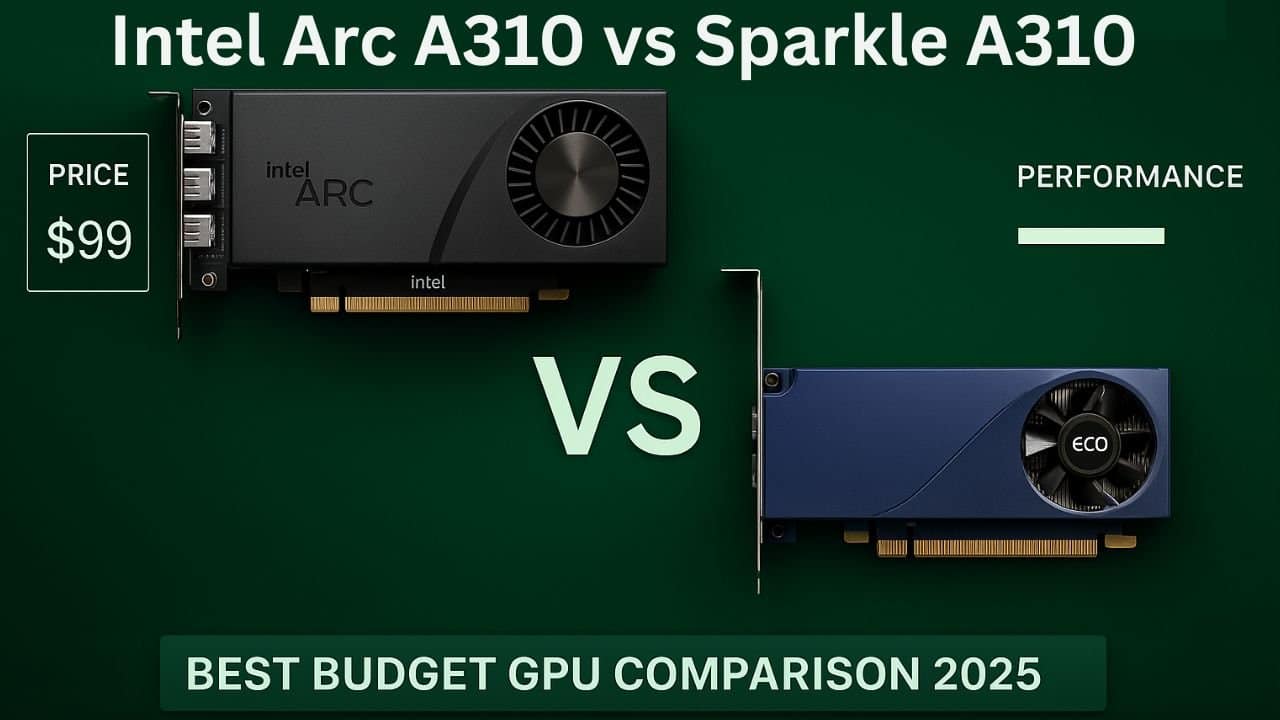Table of Contents
When it comes to entry level GPUs, Intel’s Arc A310 series has gained a lot of attention from budget builders, media creators, and those who want modern features like AV1 hardware encoding without breaking the bank. But there’s more than one A310 card on the market and the two most popular options are the standard Intel Arc A310 and the Sparkle Arc A310 ECO.
At first glance, they might look nearly identical, both use the same GPU architecture, the same memory configuration, and support the same video codecs. But under the hood, there are some important differences in power draw, performance, cooling, and overall design.
In this review, we’ll break down intel arc a310 vs sparkle a310 eco, compare their real-world performance, and help you decide which one makes more sense for your build.
Intel Arc A310 – Overview and Key Features
The Intel Arc A310 is part of Intel’s Alchemist GPU family, designed to bring modern graphics capabilities to budget and small form factor builds. Despite being the entry level option in the Arc series, it still packs some interesting features that make it stand out from older integrated GPUs or aging discrete cards.
Core Specs and Architecture
Here’s a quick look at the core specs:
| Feature | Intel Arc A310 |
|---|---|
| GPU Architecture | Alchemist (ACM-G11) |
| Xe Cores | 6 |
| Ray Tracing Units | 6 |
| Memory | 4 GB GDDR6 |
| Memory Bus | 64-bit |
| Memory Bandwidth | 124 GB/s |
| AV1 Encode/Decode | Yes |
| TDP | Up to 75W |
| Outputs | HDMI, DisplayPort (varies by model) |
With 6 Xe cores and 4GB of GDDR6 memory, the Arc A310 isn’t built for hardcore AAA gaming but it’s surprisingly capable for 1080p eSports titles, light workloads, and media tasks.
It also supports modern features like ray tracing (albeit basic) and AV1 encoding, which is a big plus for streamers and video editors.
Sparkle A310 ECO – What Makes It Different?
The Sparkle Intel Arc A310 ECO is essentially a customized version of the same GPU but it’s designed with power efficiency, compact builds, and silent operation in mind. Sparkle took the base A310 and optimized it for specific use cases, which leads to some noticeable differences.
Design and Power Efficiency
The biggest change in the Sparkle ECO is its power draw. Instead of using up to 75W like the standard version, the ECO model is rated for 50W. This makes it an excellent choice for small form-factor PCs, HTPC builds, or systems with limited power budgets.
Not sure what temperatures are safe for your GPU? Our GPU temperature safety guide breaks it down.
It’s also built as a low profile, single slot GPU, meaning it can fit into compact cases that a standard sized A310 might not. The cooling system is minimal but sufficient for the reduced power envelope.
| Feature | Sparkle Arc A310 ECO |
|---|---|
| GPU Architecture | Alchemist (ACM-G11) |
| Xe Cores | 6 |
| Ray Tracing Units | 6 |
| Memory | 4 GB GDDR6 |
| Memory Bus | 64-bit |
| Memory Bandwidth | 124 GB/s |
| AV1 Encode/Decode | Yes |
| TDP | 50W |
| Outputs | HDMI 2.0b, 2× Mini DisplayPort |
Learn more from Sparkle’s official product page.
Intel Arc A310 vs Sparkle A310 ECO Benchmarks
Now let’s put them head-to-head in key categories:
| Category | Intel Arc A310 | Sparkle Arc A310 ECO |
|---|---|---|
| Architecture | Alchemist (ACM-G11) | Alchemist (ACM-G11) |
| Xe Cores | 6 | 6 |
| Memory | 4 GB GDDR6 | 4 GB GDDR6 |
| TDP | 75W | 50W |
| Cooling | Dual-slot, larger cooler | Single-slot, compact |
| Performance | Slightly higher | Slightly lower |
| Power Efficiency | Good | Excellent |
| AV1 Encoding | Yes | Yes |
| Size | Standard | Low-profile |
| Price | $100–120 | $90–110 |
It’s clear that the two cards share a lot but the Sparkle A310 ECO trades a bit of performance for better efficiency and form factor.
Compare pricing on Newegg
Check availability on Amazon
Performance Benchmarks
Here’s what you can expect in terms of real-world performance:
| Title / Task | Arc A310 | Sparkle A310 ECO |
|---|---|---|
| CS:GO (1080p, Medium) | 110 FPS | 95 FPS |
| Valorant (1080p, High) | 100 FPS | 90 FPS |
| Fortnite (1080p, Medium) | 60 FPS | 52 FPS |
| 4K AV1 Encoding (Test Clip) | 1.0x Real-time | 0.95x Real-time |
The results show that the standard Arc A310 delivers slightly better frame rates, usually around 5–15% higher but the difference is not dramatic. Both cards are still best suited for light games, media PCs, and encoding tasks rather than high-end gaming rigs.
In video encoding, the difference is even smaller. Since both GPUs share the same media engine, they deliver near-identical results for AV1, H.264, and HEVC workloads.
Which GPU Is Better for Your Build?
So, which GPU should you choose? It depends on what you’re building:
Choose Intel Arc A310 if:
- You want slightly better performance for light gaming
- You have enough space and power headroom in your PC
- You plan to use it for mixed tasks including light 3D work
Choose Sparkle A310 ECO if:
- You’re building a small form-factor or HTPC system
- Power efficiency and lower noise are your top priorities
- You’re focused on media streaming, encoding, or AV1 workloads
In short:
The standard Arc A310 is a slightly stronger performer, but the Sparkle ECO version is more practical for compact, low-power builds.
YouTube Review – Sparkle Intel Arc A310 ECO
Watch Before You Buy
Before you decide to purchase the Sparkle Intel Arc A310 ECO, it’s worth watching this detailed review that covers eight important reasons you might want to reconsider. The video provides real-world insights, performance tests, and potential drawbacks that many users overlook. Watching it first can help you make a smarter decision and avoid any regrets later.
YouTube Review – Sparkle Intel Arc A310 ECO
The Intel Arc A310 is a great choice if you want a budget GPU for Plex or a small media server. It handles video decoding and streaming smoothly and uses very little power. Watch the video below to see why many people call it the “perfect Plex GPU.”
What We Think…
After testing and analyzing both cards, our conclusion is simple: there’s no outright winner, it’s all about what you need.
If you’re building a budget gaming PC or a do-it-all media machine, the standard Intel Arc A310 is the better choice because it squeezes out a bit more performance. However, if your priority is power efficiency, size, and silent operation, the Sparkle Arc A310 ECO offers incredible value with minimal performance sacrifice.
Both cards provide excellent AV1 encoding capabilities, modern features, and reliable performance for entry level GPUs and either can be the perfect fit for your setup if matched with the right use case.


After research a number of of the weblog posts in your website now, and I actually like your way of blogging. I bookmarked it to my bookmark web site list and can be checking again soon. Pls take a look at my website online as properly and let me know what you think.
You made some decent factors there. I seemed on the web for the issue and located most people will go along with along with your website.